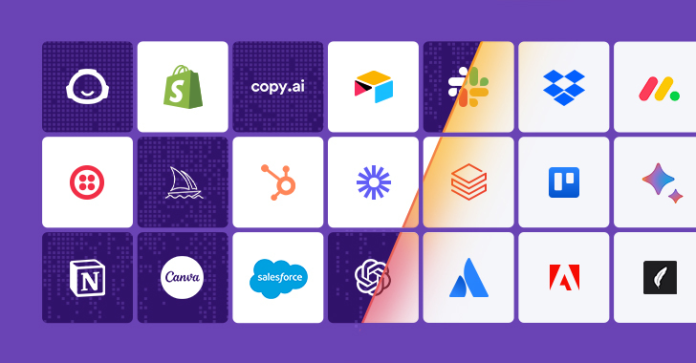
SaaS threats, some obvious and some hidden, pose significant risks to organizations. According to Wing research, a staggering 99.7% of organizations use applications with built-in AI capabilities. These AI-driven tools are essential, providing a seamless experience from collaboration and communication to work management and decision-making. But behind this convenience lies a largely unrecognized risk: the AI capabilities of these SaaS tools can compromise sensitive business data and intellectual property (IP).
Recent research findings from Wing reveal a sobering statistic: 70% of the top 10 most commonly used AI applications likely use users’ data to train their models. This goes beyond simply learning and storing the data; it may include retraining users’ data, analyzing it with human reviewers, and even sharing it with third parties.
Often, these threats lurk deep within the fine print of terms of use and privacy policies that outline data access and complex opt-out processes. This stealthy approach introduces new risks and leaves security teams struggling to maintain control. In this article, we’ll explore these risks in detail, provide real-world examples, and share best practices for protecting your organization through effective SaaS security measures.
4 Risks of Training AI on Your Data
When AI applications use data for training, several significant risks arise that can impact an organization’s privacy, security, and compliance.
1. Intellectual Property (IP) and Data Leaks
One of the most significant concerns is the potential leakage of intellectual property (IP) and confidential data through AI models. When business data is used to train AI, it can unintentionally leak proprietary information. This could include sensitive business strategies, trade secrets, and confidential communications, leading to significant vulnerabilities.
2. Data Use and Conflicts of Interest
AI applications often use data to improve their capabilities, but this can lead to conflicts of interest. For example, Wing research found that popular CRM applications use system data such as contact details, interaction history, and customer notes to train their AI models. This data is used to enhance product features and develop new ones. However, it also means that competitors using the same platform could benefit from insights derived from the data.
3. Sharing with Third Parties
Another significant risk is sharing data with third parties. Data collected for AI training may be accessible to third-party data processors. While such collaborations are intended to improve AI performance and drive software innovation, they also raise concerns about data security. Third-party vendors may not have robust data protection measures in place, increasing the risk of breaches and unauthorized data use.
4. Compliance Concerns
Various regulations around the world impose strict rules on how data can be used, stored, and shared. Ensuring compliance becomes more complex when AI applications train on your data. Non-compliance can lead to heavy fines, legal action, and reputational damage. Complying with these regulations requires significant effort and expertise, making data management even more complex.
What kind of data are they actually training on?
Understanding the data used to train AI models in SaaS applications is essential to assess potential risks and implement robust data protection measures. However, the lack of consistency and transparency across these applications presents challenges for Chief Information Security Officers (CISOs) and their security teams in identifying the specific data being used for AI training. This lack of transparency raises concerns that confidential information and intellectual property may be inadvertently leaked.
Addressing the challenge of data opt-out on AI-powered platforms
Across SaaS applications, information about opting out of data usage is often scattered and inconsistent. Some mention the opt-out option in their terms of service, others in their privacy policy, and still others require you to email the company to opt out. This inconsistency and lack of transparency complicates the work of security professionals and highlights the need for a streamlined approach to controlling data usage.
For example, some image generation applications allow you to opt out of having your data trained by selecting a private image generation option available in a paid plan. Other applications offer an opt-out option but it may affect model performance. Some applications allow individual users to adjust settings to prevent their data from being used for training.
The diversity of opt-out mechanisms highlights the need for security teams to understand and manage data usage policies across different enterprises. A centralized SaaS Security Posture Management (SSPM) solution can help by providing alerts and guidance on the opt-out options available on each platform, streamlining the process and ensuring compliance with data management policies and regulations.
After all, understanding how AI uses your data is critical to managing risk and ensuring compliance. Knowing how to opt out of data use is equally important to managing privacy and security. But without a standardized approach across AI platforms, these tasks are difficult. By prioritizing visibility, compliance, and accessible opt-out options, organizations can better protect data from AI training models. Leveraging a centralized, automated SSPM solution like Wing allows users to navigate AI data challenges with confidence and control, keeping sensitive information and intellectual property safe.


